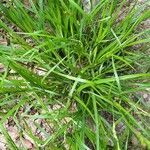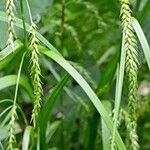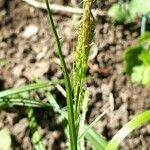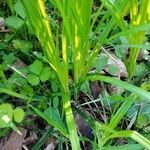Tufts light green, often dense, shortly rhizomatous, to 60 cm tall. Stems slender, ± 3-angled, smooth, often drooping, elongating to ± 1.2 m at maturity. Leaves < stems, 2-4 mm wide, soft, ± flat; sheaths hyaline, outer ones dark brown. Inflorescence with ± longer narrow leaf-like bracts below and short setaceous bracts above; spikes distant, very narrow, on much longer scabrid filiform drooping peduncles. Male spike usually 1, ± 3 cm × 1.5 mm; glumes narrow-ovate, acute, keel scabrid. Female spikes 3-5, ± 3 cm × 3 mm, very lax-flowered; glumes < utricles, ovate, acute to acuminate, hyaline, light brown with green scabrid midrib. Utricles 4-5 × 1 mm, green to brown, membranous, ellipsoid, trigonous, with two prominent lateral nerves, beak ± 2 mm long, very narrow, sparingly scabrid, bifid; stipe short. Stigmas 3. Nut ellipsoid, trigonous.
Perennial herb, tufted, up to 0.5 m high. Leaf blades 450 x 7-9 mm, flat, glabrous. Culm nodose, 3-angled, 1.5-2.0 mm in diam. Inflorescence a raceme of spikes, 200-330 mm long. Bracts 1 at each node, leaf-like. Spikes 7 or 8, erect or suberect, the largest 35-45 x 6-7 mm. Pistillate bracts (glumes) same length as and narrower than perigynium, lanceolate, 4-5 x 1.5 mm, keel excurrent into 0.5-1.0 mm long scabrid awn. Perigynium suberect, stalked, 4.5-4.7 x 1.3 mm, 3-angled with rounded base in cross section, not inflated, green or golden-brown, membranous, glabrous; rostrum 2 mm long, apex shallowly bidentate. Flowering time Nov., Jan. Nutlet elliptic, 2.3-2.4 x 1.3-1.4 mm, 3-angled, dark brown with lighter angles, surface smooth.
Much like no. 147 [Carex arctata Boott]; perigynia 5–6 mm, the body sessile, obovoid, conspicuously 2-ribbed, otherwise nerveless, the beak slender and nearly as long as the body. Native of Europe, naturalized from L.I. to s. Ont.












